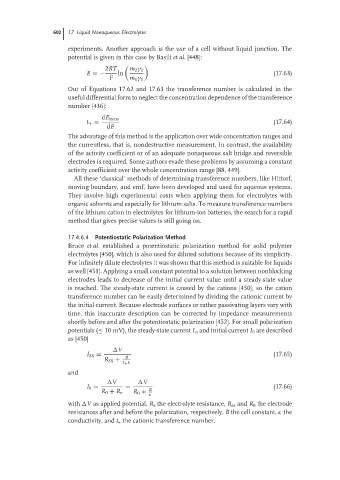Page 628 - Handbook of Battery Materials
P. 628
602 17 Liquid Nonaqueous Electrolytes
experiments. Another approach is the use of a cell without liquid junction. The
potential is given in this case by Basili et al. [448]:
2RT m 2 γ 2
E =− ln (17.63)
F m 1 γ 1
Out of Equations 17.62 and 17.63 the transference number is calculated in the
useful differential form to neglect the concentration dependence of the transference
number [436]:
dE trans
t + = (17.64)
dE
The advantage of this method is the application over wide concentration ranges and
the currentless, that is, nondestructive measurement. In contrast, the availability
of the activity coefficient or of an adequate nonaqueous salt bridge and reversible
electrodes is required. Some authors evade these problems by assuming a constant
activity coefficient over the whole concentration range [88, 449].
All these ‘classical’ methods of determining transference numbers, like Hittorf,
moving boundary, and emf, have been developed and used for aqueous systems.
They involve high experimental costs when applying them for electrolytes with
organic solvents and especially for lithium salts. To measure transference numbers
of the lithium cation in electrolytes for lithium-ion batteries, the search for a rapid
method that gives precise values is still going on.
17.4.6.4 Potentiostatic Polarization Method
Bruce et al. established a potentiostatic polarization method for solid polymer
electrolytes [450], which is also used for diluted solutions because of its simplicity.
For infinitely dilute electrolytes it was shown that this method is suitable for liquids
as well [451]. Applying a small constant potential to a solution between nonblocking
electrodes leads to decrease of the initial current value until a steady-state value
is reached. The steady-state current is caused by the cations [450], so the cation
transference number can be easily determined by dividing the cationic current by
the initial current. Because electrode surfaces or rather passivating layers vary with
time, this inaccurate description can be corrected by impedance measurements
shortly before and after the potentiostatic polarization [452]. For small polarization
potentials (≤ 10 mV), the steady-state current I ss and initial current I 0 are described
as [450]
V
I SS = B (17.65)
R SS +
t + κ
and
V V
I 0 = = B (17.66)
R 0 + R e R 0 +
κ
with V as applied potential, R e the electrolyte resistance, R ss and R 0 the electrode
resistances after and before the polarization, respectively, B the cell constant, κ the
conductivity, and t + the cationic transference number.

